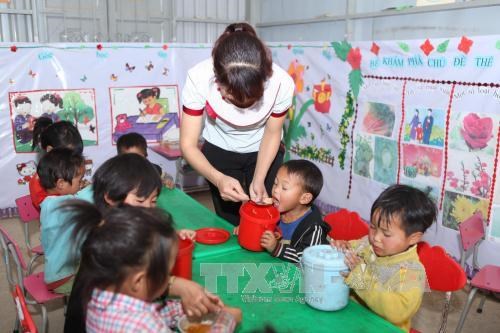Health insurance key to tackle child malnutrition
Vietnam reported about 700,000 cases of acute malnutrition each year, of which about 230,000 were severe and required medical treatment, according to Huynh Nam Phuong, deputy director of the Food and Nutrition Training Centre under the National Institute of Nutrition.
 A teacher feeds children at a preschool in San Cha Village, Dao San Commune, Phong Tho district in the northern province of Lai Chau (Photo: VNA)
A teacher feeds children at a preschool in San Cha Village, Dao San Commune, Phong Tho district in the northern province of Lai Chau (Photo: VNA)Hanoi (VNS/VNA) - Vietnam reported about 700,000 cases of acute malnutrition each year, of which about 230,000 were severe and required medical treatment, according to Huynh Nam Phuong, deputy director of the Food and Nutrition Training Centre under the National Institute of Nutrition.
Addressing a symposium held last week to discuss the treatment of acute malnutrition among children as part of the draft revised Law on Health Examination and Treatment, Phuong suggested that health insurance should cover medical treatment costs for malnourished patients.
She said malnutrition increased the risk of catching infectious diseases among children by up to 20 times.
Children with malnutrition also needed more time to recover, and malnutrition had long-term impacts on children’s mental and physical growth as well as studying ability, she said.
Acute malnutrition was caused by a decrease in food consumption and disease, for example, children often suffered from malnutrition after having diarrhoea or pneumonia.
The rate of acute malnutrition could increase sharply due to unstable food security or a pandemic, Phuong said, emphasising the need for timely assistance to ensure sufficient food and treatment for infectious diseases.
Acute malnutrition can be moderate or severe, and prolonged malnutrition can cause stunted growth. Stunting in early childhood has health consequences that can affect children throughout their entire lives.
The National Assembly’s Council for Ethnic Affairs reported that the prevalence of undernutrition among ethnic minorities mainly existed in the Central Highlands, North Central region and northern mountainous region.
One in every three Vietnamese children under the age of five was either malnourished or overweight as a result of poor diets and a food system that was failing them, according to UNICEF’s State of the World’s Children 2019 report.
Former vice head of the Child Protection Department under Ministry of Labour, Invalid and Social Affairs Nguyen Trong An said there was a close connection between acute malnutrition and stunting.
“About 6-7 percent of Vietnam’s population suffer from acute malnutrition,” An said.
“Vietnam is a top rice exporter but is also among 16 countries in the world with the highest rate of malnutrition,” An said, adding that malnutrition was not only caused by a lack of food but also a lack of micronutrients like Vitamin A and iron.
Deputy head of the Health Ministry’s Department of Legal Affairs Dinh Thi Thu Thuy suggested the State should take synchronous measures in terms of the economy, environmental hygiene, clean water supplies, food security, health care and education in order to address the issue, preventing it from becoming a burden on society.
She proposed that the examination and treatment of child malnutrition included in the Law on Health Examination and Treatment, ensuring the rights and interests of children.
“Acute malnutrition is listed internationally as a disease and there is already a treatment regimen in place for it, including inpatient examination and treatment, and outpatient treatment and consultation,” she said.
In Vietnam, there were three specialised products for treating acute malnutrition. They were not classed as medicine but still required s doctor's prescription, Thuy said.
“The Health Ministry has issued guidelines to treat acute malnutrition for children aged from 0 to 72 months. However, it’s hard for poor families to manage medical costs for acute malnutrition,” she said, calling for health insurance coverage.
Professor Hoang Van Minh, vice rector of the Hanoi University of Public Health, suggested that health insurance should cover severe acute malnutrition treatment for children aged 6-59 months, with priority given to ethnic minority and high-risk areas.
The World Health Organisation already recommends products for malnourished children, which are covered by health insurance in over 43 countries around the world.
Minh said the National Institute of Nutrition had developed products to treat severe acute malnutrition.
If Vietnam developed national standards for these products, it would pave the way for firms to start producing them so that more children would be treated and saved, Minh said.
As a result, Vietnamese people’s mental and physical development would be improved, thus increasing the quality of the country’s human resources, Minh said./.













